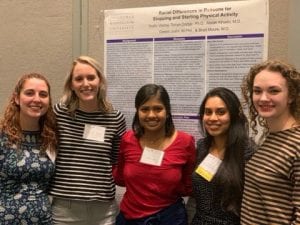Applied Social Psychology doctoral students presented their research at the Society for Behavioral Medicine conference in DC - great job!

GWU Department of Psychological and Brain Sciences
Leading research, practice, and education in the science of psychology

First semester of college represents ‘red zone’ for student drinking
What happens in the first semester of college can profoundly impact students’ alcohol use and future drinking behaviors, especially during the first six weeks, says UNTHSC Associate Professor Dana M. Litt, PhD, who is leading a new study on ways to reach freshmen when they are most impressionable.
This three-year project is funded by a $600,000 grant from the National Institute on Alcohol Abuse and Alcoholism (NIAAA), one of 27 institutes and centers comprising the National Institutes of Health (NIH).
“An extensive amount of research to date has focused on problems and prevention related to heavy drinking in college, but significantly, we see that about 25% of students who were previously non-drinkers or light drinkers often begin drinking or progress to heavy alcohol use during their freshman year,” Dr. Litt said. “Timing interventions during the first six weeks of college, the critical ‘red zone’ period, could provide an opportunity to reach these freshmen during their highest time of vulnerability for either beginning or escalating drinking.”
Dr. Litt and UNTHSC Professor Melissa A. Lewis, PhD, Co-Investigator on the study, will conduct focus groups of incoming North Texas-area college freshmen who are either non-drinkers or light drinkers to learn about their opinions and personal experiences with alcohol, and to measure the importance of friend/peer influences, personal goals and alcohol-free events and activities on campus.
Focus groups will also be asked to evaluate proposed content and delivery methods for text messaging interventions, which will then be tested with different follow-up groups of new freshmen the next year, from their first day on campus throughout the entire first two semesters.
Significantly, students themselves will be helping to create the ways to reach future freshmen down the road.
“In phase one, we want to learn what type of information these target freshmen would like to receive via text, how often, which days of the week and which times of day,” Dr. Litt said. “During phase two, as we actually follow the next groups of students from their first day forward, the value of the messaging will be assessed after the first six weeks of college, then at three, six and nine months afterward, to evaluate if they have been influenced to drink less or not to start drinking at all.”
Typically, non-drinking or light-drinking college students are considered as relatively low risk in research studies, but negative consequences measure higher among these groups if they begin or escalate alcohol use during their freshman year.
“Most freshmen are entering into a new social environment with much less parental oversight. You want to meet people and go to parties, have fun and be a part of it all, but for kids without experience, drinking can be especially risky,” Dr. Litt said. “Our goal is to support their decisions to not drink or to drink lightly, in part by correcting the belief that everyone is doing it, by reinforcing goals that don’t involve alcohol, and by encouraging these students to find non-drinking activities they enjoy where they can meet like-minded friends.”